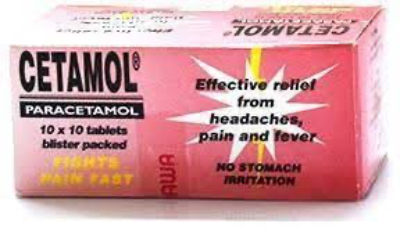


Pain - mild to moderate
Pyrexia
Treatment of post-operative pain
Dosage
Adults
500mg to 1g every 4 to 6 hours to a maximum of 4g in 24 hours.
650mg sachet:
1 sachet every four hours to a maximum of 4 sachets in any 24 hours period.
(See Dosage; Adult)
250mg to 500mg repeated every 4 to 6 hours as necessary, with a maximum of 4 doses in any 24 hour period.
650mg sachet:
Not recommended.
Other formulations are more appropriate.
The following alternate dosing schedule may be suitable:
500mg to 1g every 4 to 6 hours (maximum 4 doses in 24 hours)
480mg to 750mg every 4 to 6 hours (maximum 4 doses in 24 hours)
480mg to 500mg every 4 to 6 hours when necessary. (Maximum of 4 doses in 24 hours)
360mg to 375mg every 4 to 6 hours when necessary. (Maximum of 4 doses in 24 hours)
240mg to 250mg every 4 to 6 hours when necessary. (Maximum of 4 doses in 24 hours)
1g every 4 to 6 hours (maximum 4 doses in 24 hours)
20mg/kg to 30mg/kg (maximum 1g) as a single dose then 15mg/kg to 20mg/kg every 4 to 6 hours; maximum 75mg/kg (maximum 4g daily in divided doses).
Children under 6 years
Frail elderly patients
Restricted sodium intake
Weight below 50kg
Alcoholism
Dehydration
Gilbert's syndrome
Glucose-galactose malabsorption syndrome
Hepatic impairment
Hereditary fructose intolerance
Non-cirrhotic alcoholic liver disease
Phenylketonuria
Severe malnutrition
Severe renal impairment
Sodium content of formulation may be significant
Some formulations contain aspartame - caution in phenylketonuria
Not all available brands are licensed for all age groups
Not all formulations are licensed for all uses
Presentations with sorbitol unsuitable in hereditary fructose intolerance
Some formulations contain sucrose
Advise patient to seek medical advice if severe skin reaction occurs
Overdosage causes liver damage
Seek urgent medical advice in event of overdose, even if patient feels well
Discontinue if drug-related rash or other hypersensitivity reactions occur
Advise that alcohol increases the chances of liver damage with paracetamol
Consult doctor if symptoms persist or treatment is required for > 3 days
Patients should not exceed recommended dose
Paracetamol is considered safe for use in pregnancy.
Manufacturers suggest no adverse effects have been reported using this drug during pregnancy when used in the recommended dosage, but patients should follow the advice of their doctor regarding its use. Animal studies do not indicate reproductive toxicity.
Schaefer (2015) suggests paracetamol does cross the placenta, however due to the drugs analgesic and antipyretic properties, it is the preferred drug of choice to use in pregnancy. Briggs (2015) states that paracetamol is commonly used in all stages of pregnancy and the therapeutic doses in short-term are deemed safe, while routine use should be avoided.
Paracetamol is considered safe for use in breastfeeding.
Manufacturers suggests there has been no adverse effects on the breastfed infants and newborns when used at therapeutic doses. Schaefer (2015) suggests paracetamol is the analgesic of first choice in breastfeeding. Hale and the Drugs and Lactation Database (LactMed) both suggest the potential amount of paracetamol ingested via breast milk by an infant is likely to be significantly less than the paediatric therapeutic dose.
Abdominal pain
Abnormal vision
Agranulocytosis
Allergic reaction
Anaphylactic reaction
Anaphylactic shock
Angioedema
Blood dyscrasias
Bronchospasm
Changes in hepatic function
Confusion
Depression
Diarrhoea
Dizziness
Erythema multiforme
Haemolytic anaemia
Haemorrhage
Hallucinations
Headache
Hepatic disorders
Hepatic failure
Hepatitis
Hepatotoxicity
Hypoglycaemia
Interstitial nephritis
Jaundice
Leucopenia
Liver damage
Malaise
Nausea
Neutropenia
Oedema
Pancytopenia
Papillary necrosis
Pruritus
Purpura
Pyrexia
Rash
Renal impairment
Sedation
Stevens-Johnson syndrome
Sweating
Thrombocytopenia
Toxic epidermal necrolysis
Tremor
Urticaria
Vertigo
Vomiting